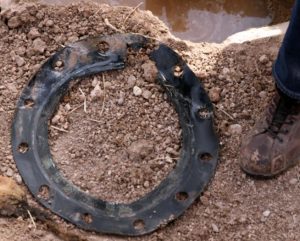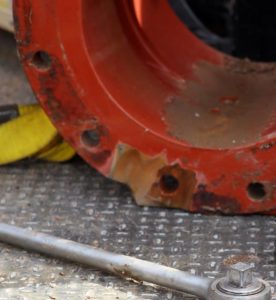Recent gasket failures in flanged joints of High Density Polyethylene (HDPE) piping.
Problem
HDPE piping joints are typically thermal fusion welded joints, but flanges may also be used. When flanges are used, an HDPE flange adapter with a metal backing ring is fused to HDPE piping, as shown in Figure 1. The HDPE flange adapters are used to connect to other flanged fittings, such as valves, elbows, tees, etc., with gaskets inserted between the flanged fittings.
Incident Description


Because HDPE will relax after the flange bolts are torqued, a re-torque after 24 hours is required. Even after the bolts are re-torqued, the face stresses drop to 400–600 psi. The lower face stress reduces the friction for maintaining the gasket in between the flange faces. The challenge is finding a gasket that can handle pressures that may exceed 200 psi, gauge (psig), but also seal well at relatively low stresses.
Due to the many inquiries from customers and engineering firms for gasket applications involving HDPE piping, Garlock, a gasket manufacturer, published a memo in January 2017 recommending using either GYLON® Style 3545 or MULTI-SWELL™ Styles 3760/3760U as the best options for HDPE flanges, even though the available compressive loads are lower than recommended. The reinforced gasket material of the GYLON and MULTI-SWELL has proven to prevent the internal water pressure from damaging the gasket under low-compression loads.
Other gasket manufacturers may have similar gaskets that will work for this application. It is important for the Design Engineer to work with the gasket manufacturer to properly specify the correct gasket.
Recommendations to HPDE Piping and Flanged Joints
When using HPDE piping with flanged joints, ensure that the flange bolts are re-torqued at least 24 hours after gasket installation.
When evaluating gasket material, be sure to include any surge pressure that could be caused by opening valve and starting pumps. Also, include any additional design/safety factors in your gasket calculation. And, directly work with the gasket manufacturer in making a selection.
If you have questions about HPDE piping and flanged joints or any other engineering applications, contact Gallagher Fluid Seals.
Original article written by Brian Rhodes, Department of Energy.
- References include:
- Garlock Sealing Technologies Memo
- Plastic Pipe Institute TN-38, Bolt Torque for Polyethylene Flanged Joints
